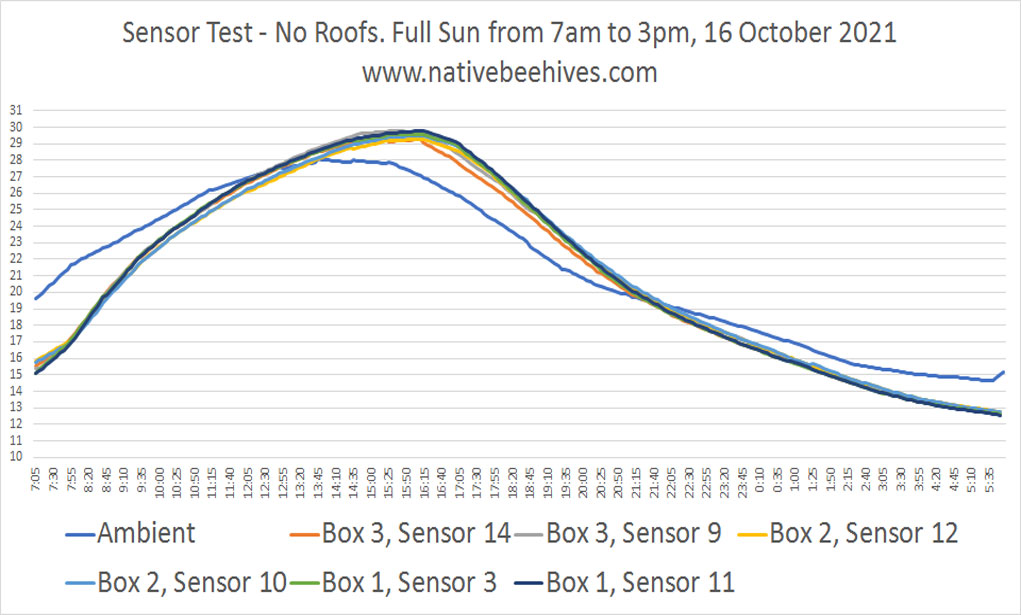Roof Testing – Full Sun – August – October 2021
I’m having a look at a some roof designs and trying to gauge how effectively they reduce box heat in summer. You might think it’s obvious that a roof will help keep a hive box cool, but how effective is it? It could end up being more about the box than the roof?
Roofs: The large roof pictured is 10mm thick PVC supplied by Alex at Spicers Hollow Native Bees. The other roof shown is one of my 15mm thick pine roofs painted white.
Boxes. All boxes are the same as each other for each individual test listed below. 35mm thick Cypress painted white and 33mm Hoop Pine painted pale yellow.
Sensors: Each box and roof has two temperature sensors, one directly on top of the box (under the roof) and one inside the box. The box with no roof just has one sensor inside. There’s also a sensor in the shade for ambient temperature.
Future tests: These tests are just really sorting out the testing methods and trying to understand the results. There could be variances in sensor data, box position etc etc. I’ll continue to do these test over the coming summer and hopefully get more accurate results.
Test 1: Sensor Check

Firstly, to put nine sensors together and check that they all read the same. The down spike is where i placed them in the freezer.
For this sensor test they were set at 10 minute intervals which improved the syncronisation a fair bit. I have now set the sensors at 5 minute intervals which might be more accurate.
Test 2: Three Empty Boxes – Sensor Check

This test is with three empty boxes to make sure they all read the same in the chart. Differences in position and sun exposure could affect the results which would skew the next tests with the roofs in place.
- Three boxes, 35mm thick Cypress painted white
- No roofs
- Two sensors inside each box
- Boxes in full and equal amount of sun from 7am to 3pm
- For the box and roof tests i’ll continue to swap the sensors and box position around.

Test 3: 17 October 2021

- Boxes facing north
- Three boxes, 35mm thick Cypress painted white
- Box 1; No Roof
- Box 2: Wood Roof painted white, 15mm thick
- Box 3: PVC Roof white, 10mm thick
Observations: The thick white painted boxes work pretty well without a roof so the roof doesn’t seem to make a lot of difference. Both roofs are fairly equal here lowering the internal box temperature by around one degree when compared to the box without a roof. The temperatures directly under the roofs are pretty much the same as each other.

Test 4: 19 October 2021

- Boxes facing east
- Three boxes, 35mm thick Cypress painted white
- Box 1; No Roof
- Box 2: Wood Roof painted white, 15mm thick
- Box 3: PVC Roof white, 10mm thick
Observations: It looks like the larger PVC roof may have provided more shade for the side slowing down the internal box temperature early in the day, though both box internal temps peaked at the same temp at the same time, around 3pm, same as the previous test. Temps directly under the roof were the same all day. Internal box temperatures are 1 – 2 degrees lower than the box without a roof.

Test 5: 20 October 2021

- Boxes facing east
- Three boxes, 33mm thick Hoop Pine painted pale yellow
- Box 1; No Roof
- Box 2: Wood Roof painted white, 15mm thick
- Box 3: PVC Roof white, 10mm thick
Observations: Full shade on the sides of the boxes from both roofs during the hottest time of the day. No major differences between boxes and roofs here. Boxes with roofs are 1 degree lower than the box without a roof.


Test 6: 24 October 2021. 34 degrees C
- Boxes facing east
- Three boxes, 33mm thick Hoop Pine painted pale yellow
- Box 1; No Roof
- Box 2: Wood Roof painted white, 15mm thick
- Box 3: PVC Roof white, 10mm thick
Observations: At the hottest part of the day the boxes with roofs were within 1 degree. No dramatic differences.
Chart 1 – Temp Sensors: The box with the smaller wood roof warmed up earlier with more sun on the sides in the morning. The wood roof stayed a little cooler for longer, maybe because of it’s thickness.
Chart 2 – Surface Temperatures: In full sun at 34 degrees C, the PVC material surface temperature was cooler than the painted wood surface temperature. The painted wood had more insulation compared to the PVC material. The angle at which the sun hits the surface can change the surface temperature.













